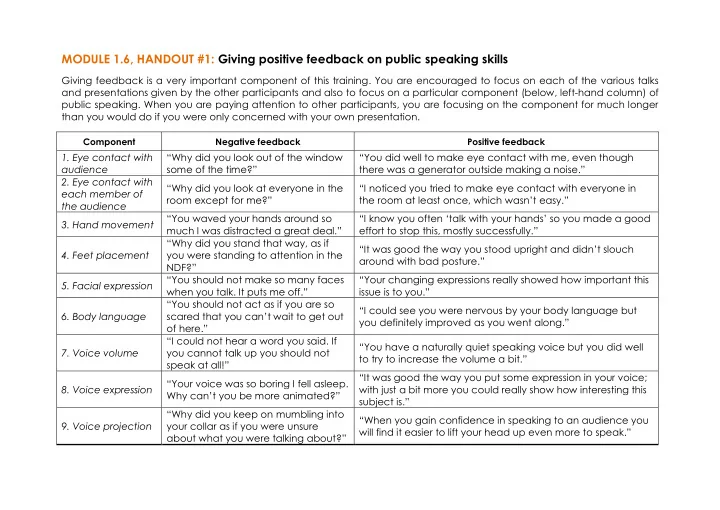

MODULE 1.6, HANDOUT #1: Giving positive feedback on public speaking skills Giving feedback is a very important component of this training. You are encouraged to focus on each of the various talks and presentations given by the other participants and also to focus on a particular component (below, left-hand column) of public speaking. When you are paying attention to other participants, you are focusing on the component for much longer than you would do if you were only concerned with your own presentation. Component Negative feedback Positive feedback 1. Eye contact with “Why did you look out of the window “You did well to make eye contact with me, even though audience some of the time?” there was a generator outside making a noise. ” 2. Eye contact with “Why did you look at everyone in the “I noticed you tried to make eye contact with everyone in each member of room except for me?” the room at least once, which wasn‟t easy. ” the audience “You waved your hands around so “I know you often „talk with your hands‟ so you made a good 3. Hand movement much I was distracted a great deal. ” effort to stop this, mostly successfully. ” “Why did you stand that way, as if “It was good the way you stood upright and didn‟t slouch 4. Feet placement you were standing to attention in the around with bad posture. ” NDF?” “You should not make so many faces “Your changing expressions really showed how important this 5. Facial expression when you talk. It puts me off. ” issue is to you. ” “You should not act as if you are so “I could see you were nervous by your body language but 6. Body language scared that you can‟t wait to get out you definitely improved as you went along. ” of here. ” “I could not hear a word you said. If “You have a naturally quiet speaking voice but you did well 7. Voice volume you cannot talk up you should not to try to increase the volume a bit. ” speak at all! ” “It was good the way you put some expression in your voice; “Your voice was so boring I fell asleep . 8. Voice expression with just a bit more you could really show how interesting this Why can‟t y ou be more animated? ” subject is. ” “Why did you keep on mumbling into “ When you gain confidence in speaking to an audience you 9. Voice projection your collar as if you were unsure will find it easier to lift your head up even more to speak.” about what you were talking about ?”
MODULE 1.6, HANDOUT #2: Single person eye contact skills 1. FISH 2. MIELIES (CORN)
MODULE 1.6, HANDOUT #3: Individual audience member s’ eye contact skills 1. COW 2. SNAKE 3. OSTRICH 4. RAT
MODULE 1.6, HANDOUT #4: Using our hands in an appropriate manner when speaking 1. NURSE 2. PILOT 2. MINER 4. TAXI DRIVER
MODULE 1.6, HANDOUT #5: Feet placement and talking about tricky issues 1. POLICEWOMAN 2. ROBBER 3. WOMAN TEACHER 4. HUNTER
MODULE 1.6, HANDOUT #6: Changing our faces can change our meaning 1. DRINKING 2. OVEREATING
MODULE 1.6, HANDOUT #7: Being aware of our body language GROUP 1. DRUG AND ALCOHOL ABUSE GROUP 2. HIV IN AFRICA
MODULE 1.6, HANDOUT #8: Using our voices effectively GROUP #1 “My cousin’s car is at the panelbeaters now. Guess who put it there?” (voice EXPRESSION) GROUP #2 “Since my father died suddenly, I am head of this household.” (voice VOLUME) GROUP #3 “Where has my firstborn gone? I have been searching for her all day. (voice PROJECTION) Must I find her at the shebeen with my sister ?”
MODULE 1.6, HANDOUT #9: Preparing for my presentation TOPIC: What am I going to say (summarise ONLY or draw a picture or Evaluation (did I Presentation step symbol to guide you) cover all content?) 1. Introduce 2. Explain 3. Discuss 4. Go into detail 5. Finishing up 6. Q&A
MODULE 1.6, HANDOUT #10: Self-assessment evaluation for participants Participants receiving training in Module 1.6 are not subject to formal assessment. However, in order for you to assess the knowledge and skills you have acquired on public speaking and presentation, and for the trainer to ascertain how effective the training has been, you are encouraged to answer for yourself the following questions and discuss your answers ‒ as part of a group or individually ‒ with your trainer. 1. Can I describe why it is important to develop good public speaking and presentation skills? 2. Can I provide a definition of gender balance and explain why it is important? 3. Can I give reasons why women might feel unable to express themselves freely in public and how these factors can be addressed? 4. Can I list the 9 components of good public speaking to do with my body and voice? 5. Can I list the three different ways that I can alter the way that I use my voice? 6. Can I identify the 6 presentation steps I used during my talk today? 7. What aspects of public speaking do I feel I must still work on? 8. What aspects of public speaking do I have confidence in?
Recommend
More recommend